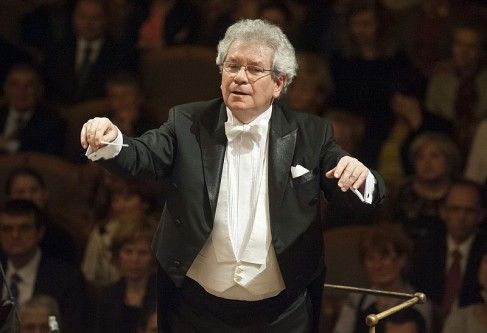 Como hoje é domingo e estou com preguiça de escrever, fiz um crtl+c crtl+v e copiei o texto do booklet desta excepcional gravação de uma obra capital da música ocidental, e que revelou um dos grandes compositores do século XIX, Bedřich Smetana. O regente é o também tcheco Jiří Bělohlávek, falecido em maio do ano passado. Esta foi uma de suas últimas gravações e com certeza podemos dizer que está no mesmo nível das realizadas por seu conterrâneo Rafael Kubelik.
Como hoje é domingo e estou com preguiça de escrever, fiz um crtl+c crtl+v e copiei o texto do booklet desta excepcional gravação de uma obra capital da música ocidental, e que revelou um dos grandes compositores do século XIX, Bedřich Smetana. O regente é o também tcheco Jiří Bělohlávek, falecido em maio do ano passado. Esta foi uma de suas últimas gravações e com certeza podemos dizer que está no mesmo nível das realizadas por seu conterrâneo Rafael Kubelik.
“Bedřich Smetana’s reputation as the father of Czech music was sealed by the six symphonic poems known as Má vlast (“My Homeland”). The sparkling musical depictions of his beloved Bohemian landscape, of its vibrant culture and proud history, have come to represent the unquenchable spirit of the Czech nation. What gives this recording such power is the fact that the Czech Philharmonic, and their great conductor Jiří Bělohlávek, have this music in their blood. Smetana was born in 1824 in Litomyšl, Bohemia, a province dominated politically, culturally and linguistically by the giant Austrian Empire. Unable to establish a career in Prague, he spent most of his early career in Gothenburg, Sweden, but often wrote of his longing to return. It was Franz Liszt, his teacher and friend, who visited him and kept him in touch with the wider musical world. As the Habsburg grip weakened, the smaller nations started to assert their independence. In 1861 Smetana returned to Prague ready to play a leading role in establishing a national style of composition. His Bohemian themed operas, such as The Bartered Bride, met with public success, but conservatives called him a “dangerous modernist” and insisted that his operas could not be models for Czech national opera because they were tainted by the progressive ideas of Wagner and Liszt. Nevertheless it was a form pioneered by Liszt — the symphonic poem — that turned out to be the ideal vehicle for expressing Smetana’s patriotic sentiments. After early experiments with the form in Sweden, he began Má vlast in 1872, developing a Romantic, distinctively Czech sound-world that captured the rhythm, colour and sounds of Czech life and culture. The first poem, Vyšehrad, was finished in 1874, with Vltava following a few months later. Vyšehrad is the great rock standing above Prague and the site of a commanding castle that saw triumph and tragedy over the centuries. Smetana describes the story to his publisher: “The harps of the bards begin; a bard sings of the events that have taken place on Vyšehrad, of the glory, splendour, tournaments, and battles, and finally its downfall and ruin. The composition ends on an elegiac note.” Vltava (or Die Moldau, in German) has always been the most popular of the six movements, and it is one of music’s greatest landscape paintings. A masterly evocation of flowing water, it was written after Smetana visited the countryside with his friend, the conductor Mori Anger, to find the exact spot where the two river Vltavas met. His characterful portrait of the river at the heart of his country describes its passage from the hills of South Bohemia, through forests and meadows, passing a hunt, a wedding and a bevy of water-sprites, before making a spectacular arrival in Prague. Smetana brings back the music from the opening poem as the river flows beneath the great rock of Vyšehrad and disappears into the distance to join the Labe (Elbe) river and ultimately the sea. The two movements were performed in Prague in 1875, but sadly Smetana was unable to hear them. He had lost the hearing in both ears after a sudden acute ear infection. In his last decade he threw himself into composition, adding four more movements to Má vlast. Šárka celebrates the legendary Czech warrior princess, who extracts bloody revenge after her lover is unfaithful. By contrast, Zčeských luhů a hájů (From Bohemian Fields and Groves) is a joyful work, full of the sounds and sights of country life, including birdsong and a lusty village polka. The final two movements are linked by subject and musical material, with the chorale “Ktož jsú boží bojovníci” (“Those who are warriors of God”) as the centrepiece of both. Tábor was the stronghold of the Hussite Rebellion, the fifteenth-century political and religious movement dedicated to Bohemian independence. Blaník refers to the White Mountain, a sort of Czech Valhalla where Hussite warriors slumber through the centuries, ready to come to the rescue of the homeland. “Hence, the chorale that was used as the basic motive in Tábor is also used as the foundation of this piece”, wrote Smetana. “It is on the basis of this melody, the Hussite chorale, that the resurrection of the Czech nation, its future happiness and glory, will develop.” The complete work was performed in Prague in 1882, when it was acclaimed as the true representation of Czech national style. “Everyone rose to their feet and the same storm of unending applause was repeated after each of the six parts”, wrote Smetana’s biographer Václav Zelený. Two years later Smetana died in an asylum in Prague and was given a hero’s funeral. His grave is in the Vyšehrad Cemetery, the name a fitting reminder of his greatest work.”
Amanda Holloway
01. Smetana- Má Vlast, JB1-112-1. Vysehrad
02. Smetana- Má Vlast, JB1-112-2. Vltava
03. Smetana- Má Vlast, JB1-112-3. Sarka
04. Smetana- Má Vlast, JB1-112-4. Z ceskych luhu a haju
05. Smetana- Má Vlast, JB1-112-5. Tábor
06. Smetana- Má Vlast, JB1-112-6. Blanik
Jiří Bělohlávek
Czech Philharmonic Orchestra

Esplendido disco y gran grabación. gracias por este regalo.
Grande fdp, saudações! Baixei o arquivo do Smetana, mas nem chego a conseguir que o 7z o aproveite. Pelo jeito, ninguém mais reclamou.
Alguma receita?
experimentou usar o winrar?